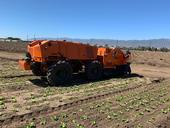- Author: Michelle Leinfelder-Miles
- Posted by: Gale Perez

In 2022, I estimate rice acreage in the Delta, south of the Yolo Bypass, was at least 8,000 acres. Most Delta rice is grown in San Joaquin County, but there is some acreage in Sacramento County. While Delta rice acreage is relatively small compared to that in the Sacramento Valley, it has been steadily increasing over the last several years (Table 1).
Given the increasing interest in rice production among Delta growers, and the differences in production practices from the Sacramento Valley, UC Cooperative Extension and UC Davis will be releasing a cost of production report specifically for Delta rice later this year or in early 2023. A Delta rice cost study was...
- Posted by: Gale Perez

Position: Agronomy and Weed Management Advisor Applied Research and Extension (AP#22-06) Merced
Location: This position will be headquartered in the UCCE Merced County office in Merced, CA but will also serve Stanislaus and San Joaquin counties.
Closing date: September 26, 2022
Job Description: https://ucanr.edu/About/Jobs/?jobnum=2220
UC ANR is hiring an Agronomy and Weed Management Advisor located at UCCE Merced, in Merced, CA. For more information and how to apply, follow...
- Author: Whitney Brim-DeForest
- Posted by: Gale Perez

It is getting close to the time we need to scout for weedy rice. Our team will be scouting known infested fields that are planted to rice this year. Troy Clark, our Rice Junior Specialist, will be starting in the next few weeks, and will be reaching out to growers and PCA's. Like always, the more eyes on the ground we have, the better! So we are asking for everyone to please scout their own fields to look for suspicious plants.
For timing of scouting, the best time to start, is if you have applied all herbicides to control grasses, and you are still seeing what appear to be skips or misses in grass control. At that point, it is a good idea to go out and check the plants. If they do not have a ligule and auricle, then they...
- Author: Richard Smith
- Posted by: Gale Perez

Richard Smith is the UC Cooperative Extension Vegetable Crop Production and Weed Science Farm Advisor in Monterey, Santa Cruz and San Benito counties.
Automated weeders remove weeds inside the three- to five-inch-wide uncultivated band left around the seedline by standard cultivation. Automated weeder technology has improved significantly over the past decade. All automated weeders use 1) cameras to detect plants, 2) a computer to process the image and make decisions about which plants to keep and which to remove and 3) a kill mechanism. Kill mechanism that operates in the seedline used by currently available machines are either a split blade that opens around keeper...
- Author: Todd Fitchette
- Posted by: Gale Perez

From Western FarmPress
The UC is suggesting practices that could help control spread of the wild rice type.
Written by Todd Fitchette | Apr 20, 2021
California rice growers with troublesome patches of weedy rice, or red rice, may want to...


